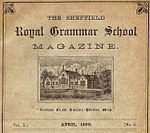The Mount, Sheffield
1832 establishments in EnglandAvivaGrade II* listed buildings in SheffieldHistory of SheffieldHouses completed in 1832 ... and 1 more
Use British English from March 2018

The Mount is a Grade II* listed building situated on Glossop Road in the Broomhill area of Sheffield in England. It stands just over 1.3 miles (2.1 km) west of the city centre. It is a neoclassical building which was originally a terrace of eight houses but since the 1950s has been used for commercial office space for various businesses. The building is part of the Broomhill Conservation Area, which was set up in March 1977 through an agreement with local residents and Sheffield City Council.
Excerpt from the Wikipedia article The Mount, Sheffield (License: CC BY-SA 3.0, Authors, Images).The Mount, Sheffield
Newbould Lane, Sheffield Broomhill
Geographical coordinates (GPS) Address Nearby Places Show on map
Geographical coordinates (GPS)
| Latitude | Longitude |
|---|---|
| N 53.3768 ° | E -1.4989 ° |
Address
Newbould Lane
Newbould Lane
S10 2PL Sheffield, Broomhill
England, United Kingdom
Open on Google Maps







